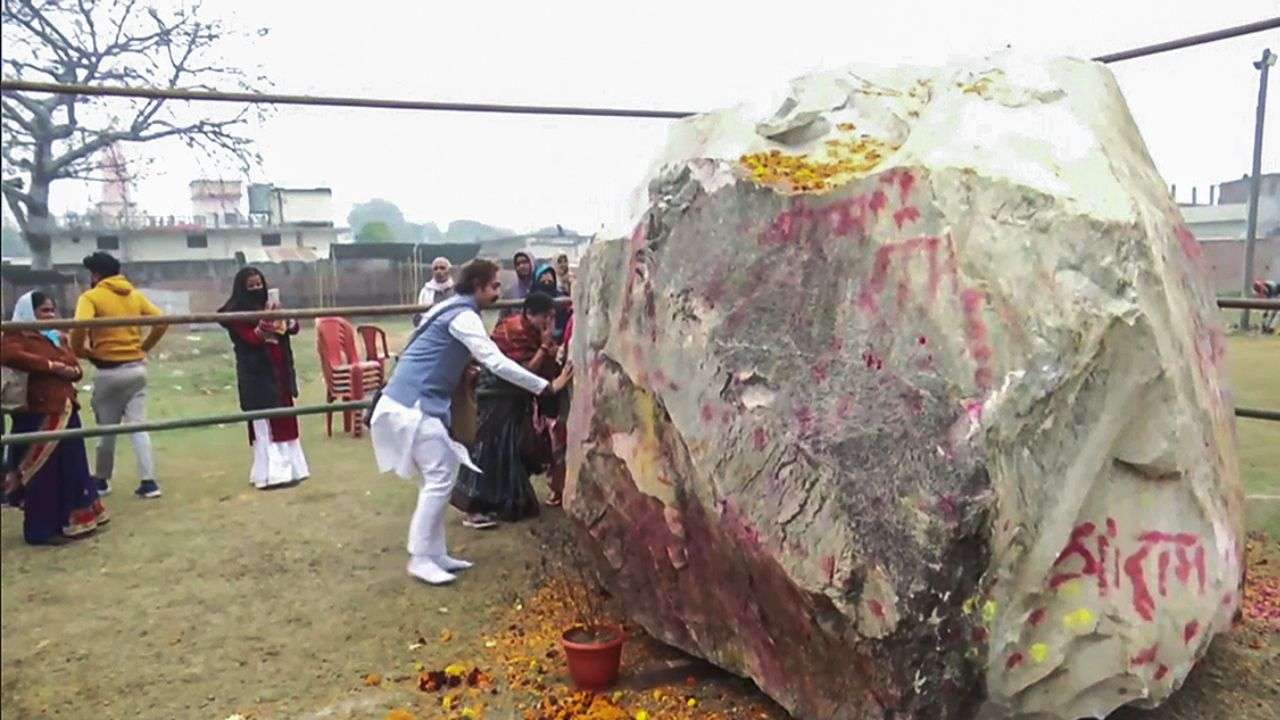From Nepal’s Mystical Hills to Ayodhya Ram Mandir: What Happened to the Sacred Stones?
As the consecration day of the Ram temple in Ayodhya took place yesterday that is on December 28, 2023, there’s growing talk about the stones that came from Nepal to craft the idol of Ram for this temple.

It is noteworthy that after finishing the construction of the Ram temple, two massive stones were transported to Ayodhya from the Kaligandaki riverbank in Nepal back in February.
These stones weighed 14 and 27 tonnes respectively. They were gathered from the banks of the Kali River and were brought to Ayodhya through Janakpur’s Janaki temple.
Initially, there was excitement that these stones would be used for crafting the idols of Ram. However, later it was discovered that these stones weren’t suitable for creating the Ram idols.
Indian media reports suggest that one reason for not using these stones to make the idol was the objection raised by saints associated with the Ram temple.

According to the insider’s information, there were differing opinions among religious leaders regarding the use of stones brought from Nepal for making the idol.
Some of these leaders believed that these stones, gathered from the Kaligandaki riverbank, were sacred and should not be broken, as they were considered equivalent to Shaligram, a sacred fossil stone.
Courtesy – Namaste World – YouTube
However, representatives from Nepal, who examined the stones, shared a technical perspective.
They explained that, after attempting to carve a statue from a 27-tonne stone, it was found impractical. Both the 27-tonne and 14-tonne stones, initially considered sacred, were not suitable for carving idols.
Consequently, these stones are now placed near the construction site of the Ram temple.
On another note, Indian media reports indicate that three idols have been crafted using stones from various locations across the country.
These idols are intended for the sanctum sanctorum of the Ram temple. A selection process will determine the best idol, which will eventually be installed in the main chamber of the temple.
When will the consecration take place?
The Shri Ram Janmabhoomi Teertha Kshetra Trust, overseeing the construction of the Ram temple in Ayodhya, has announced that the Pran Pratishtha program is scheduled for January 22.
Invitations are being extended to guests, and preparations for the event are in full swing. Here’s a list of invitees below:
ALSO, READ / Ayodhya Ram Mandir Inauguration: Who’s In and Who’s Out…
Read More at hydnewstoday.com/ayodhya-ram-mandir-inauguration-whos-in-and-whos-out/ © HydNewsToday
The construction of the temple’s inner sanctum is ongoing day and night, with dedicated efforts to ensure timely completion.

Notably, special guests, including Prime Minister Narendra Modi, from both within the country and abroad, are expected to attend the consecration program. Simultaneously, the process of selecting priests for the new temple is underway.
Where are the stones brought from Nepal?
Following the decision not to use the stones from Nepal for making statues, the MEDIA has reached out to officials from both Nepal and India to ascertain the current status and use of these stones.
As of the time of reporting, specific details about the condition or location of these stones remain unclear.
However, Bimalendra Nidhi, the former deputy prime minister and leader of the Nepali Congress, who proposed sending the stones to Ayodhya, shared that he has been informed that the stones have been safely preserved.
Nidhi stated, “Since it wasn’t suitable to make the idol from that stone, I’ve been told that it has been securely kept at the location where the Ram temple is being constructed.”
He added, “Even though the idol isn’t being made, the sacred stone is planned to be installed in the temple premises with due respect for worship by the people.”
Traditionally, individuals from Ayodhya visit the Janaki temple in Janakpur on their wedding day.
In line with this tradition, Nepal offered to send foundation stones to Kaligandaki after the Supreme Court cleared the way for the construction of the Ram temple in Ayodhya, India.
Surat KC, the mayor of Beni municipality, from where the stones were sent, expressed disappointment that statues were not crafted from the stones.
He conveyed, “I have suggested that if these stones are not used for idols, they should be brought back.
Despite the pressure to create idols from these stones, it didn’t happen. Our stance is that given the way we sent these stones, they should be given a respectful place.”
Decision to send stones
Following a proposal from Nepal, the Ram Temple Construction Committee in Ayodhya reached out to the Janaki Temple, requesting stones.

Subsequently, the Nepal government formally decided to send these stones to India.
The Gandaki province government of Nepal coordinated with the Janaki Temple management to send these stones to Ayodhya.
During this process, officials from the Shri Ram Janmabhoomi Teertha Kshetra Trust, responsible for overseeing the temple construction, visited Nepal and stayed for a few days to identify the stones before their transportation to Ayodhya.
Upon sending the stones to Ayodhya, a copperplate was included with them.
Three copies of this copperplate were sent to the Federal Government of Nepal, the Government of Gandaki Province, and the Janaki Temple.
The inscription on the copperplate, dated January 12 of the previous year, mentions the agreement between the Government of Nepal and the decision of the Gandaki Province Government to provide two stones for the construction of the Shri Ramlila statue in Ayodhya from the Kaligandaki River area.
The completion of the work in conferring the Janaki Temple in Janakpurdham is also noted, credited to Chief Minister Khagraj Adhikari.
What do government officials say on the rock?
When questioned about the discrepancy between the initial intention of sending the stone for idol creation, as mentioned in the copperplate, and the subsequent decision not to make the idol in Ayodhya, Sushila Sikhada, Social Development Minister of the Gandaki state government, expressed ignorance on the matter.
She stated, “I don’t know about it right now. I will let you know later.”

On this issue, the foreign run media outlet BBC also sought clarification from Ramroshan Das, the priest of Janakpur’s Janaki Temple, regarding the current status of the stones taken from Nepal.
However, he responded that he was not aware of the latest developments concerning the stones. “I don’t know anything about it,” he said.
How is rock used?
Representatives from Nepal have mentioned that even though idols have not been constructed from the stones, they will be revered as Shaligram. Kulraj Chalise, involved in the process of sending these stones, has conveyed that he learned the stones would be kept within the temple premises.
Chalise, recognized for his understanding of the cultural significance of Shaligram, mentioned that trust officials informed him that the smaller stone would be installed as Shaligram and the larger stone as its base.
Decision to build Ram Mandir
Prime Minister Narendra Modi laid the foundation stone for the Ram Temple in Ayodhya on August 5, 2020.

This significant event followed the demolition of the Babri Masjid in 1992, leading to a prolonged legal battle between the Hindu and Muslim sides, progressing from the Allahabad High Court to the Supreme Court.
In November 2019, a historic verdict was delivered, affirming that the temple should be constructed on the disputed land in Ayodhya.
The decision also mandated the central government to allocate five acres of alternative land to the Sunni Waqf Board for the construction of a mosque.
This resolution marked a crucial milestone in the longstanding Ayodhya land dispute.









